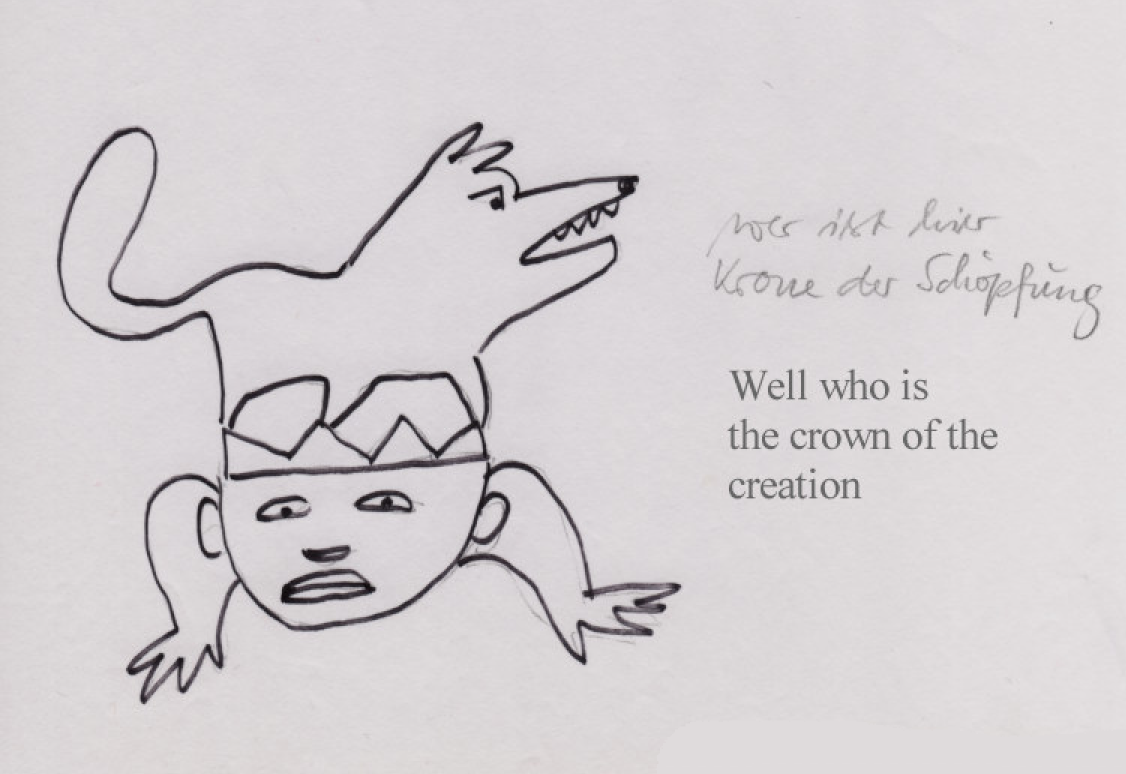Tiersoziologie als Schnittstelle zwischen Tierrechtler:innen und Tieren
Wenn sich eine Aussage wie die folgende auf das Mensch-Tier-Verhältnis bezieht, so ist es nur logisch sowohl:
1.) Nichtmenschen statt in biologistische Rahmen zu zwängen in ihrer eigenen Soziologie zu respektieren
2.) Und dass gleichermaßen auch ein Tier-Mensch-Verhältnis perspektivisch besteht
3.) Und nicht zuletzt, dass selbst der Überhang zum Stratum des Ökosozialen auch ein Bezug ist, in dem Tiere insbesondere, aber auch Menschen, soziale und psychologische Bezugnahme zu „Mitleben“ und Koexistenz zum Ausdruck bringen und manifestieren.
„Die soziologische Untersuchung von Tieren
Nachdem wir davon ausgehen, dass Tiere bewusste soziale Akteure sind, die sich für soziologische Studien eignen, wollen wir nun untersuchen, wie eine solche Arbeit tatsächlich durchgeführt werden kann. Beispiele stammen aus verschiedenen theoretischen Traditionen und haben eine Reihe von Rollen untersucht, die verschiedene Tiere in der sogenannten menschlichen Gesellschaft spielen (Stuart et al. 2013, 201-2). Wie oben gezeigt wurde, lag der Schwerpunkt auf Haustieren, die stark in menschliche soziale Gruppen integriert sind, aber auch ‚Nutztiere‘, Zootiere und wilde/halbwilde Tiere wurden untersucht. Durch das Erreichen einzigartiger und nützlicher Schlussfolgerungen über das miteinander verbundene Leben von Tieren und Menschen und die Bedeutung von Tieren für umfassendere soziale Systeme zeigt diese Arbeit, dass die Verwendung soziologischer Methoden und Konzepte zur Untersuchung von Tieren nicht nur möglich ist, sondern auch einen großen Nutzen für unser Verständnis der Gesellschaft als Ganzes haben kann (Stuart et al. 2013, 218).“
Aus: Albert Ferkl: The Question of Non-Human Animals in Sociology, https://www.animalsandsociety.org/research/sloth/sloth-volume-4-no-1-winter-2018/question-non-human-animals-sociology/ [Zugriff 12.09.2023]
Wenn Tiere hier als bewusste soziale Akteure anerkannt werden, fragt sich, was genau begründet eine Negation dessen, dass Tiere untereinander sozial bedeutungsvoll interagieren? Vermutlich die Vorstellung, dass es nur einen, nämlich den anthropogenen Gesamtkontext geben könne, der soziale Interaktion erst bedeutsam machen soll.
Solche Blickwinkel muten restriktiv und rückständig an, sie bilden aber die Normalität.
Und so lassen beispielsweise auch Mitwirkende bei partizipatorisch abreitenden Seiten wie Wikipedia z.B. die Bestrebungen von Tierrechtler*innen, die sich für eine Anerkennung von Tiersoziologie in Form eines dezidiert nicht-biologistischen Erkenntnisansatzes einsetzen, unauffällig unter den Tisch fallen; als ließe sich selbst in den Schnittstellen zwischen den Tierbewegungen und deren Inhalten, und den nichtmenschlichen Tieren keine für beide Seite gleichsam relevante soziologische Bedeutung ausmachen
—
Geistig wird hier immer noch das Tier-Maschine-Modell gepflegt, nur in biologisierender Ausformulierung. Der vehemente Einsatz gegen Speziesismus und das konstruktive Interesse an der Tierfrage zahlloser Menschen wird mehr oder weniger stillschweigend als kindische Sentimentalität ausgeblendet. In Sachen der geistigen Haltung im Bezug auf Tiere versteckt sich die Mehrheit der Menschen also immer noch hinter ähnliche Blickwinkeln, wie der Vivisektor Descartes sie vertrat. Mit und ohne Aufklärung.
—
Animal sociology as an interface between animal rights activists and animals
Animal sociology as an interface between animal rights activists and animals
When a statement such as the following relates to the human-animal relationship, it is only logical to both:
1.) To respect non-humans in their own sociology instead of forcing them into biologistic frames.
2.) And that equally also an animal-human-relationship exists perspectively
3.) And last but not least, that even the overlap to the stratum of the ecosocial is also a reference in which animals in particular, but also humans, express and manifest social and psychological reference to „the co-living/co-life“ and coexistence.
Yet look for instance:
„The Sociological Study of Animals. Accepting that animals are conscious social actors suitable for sociological study, let us move on to how such work can actually be done. Examples have arisen from various theoretical traditions and have investigated a number of roles that different animals play in so-called human society (Stuart et al. 2013, 201–2). As shown above, most focus has been on pets strongly integrated into human social groups, but farm animals, zoo animals, and wild/semi-wild animals have also received attention. Through reaching unique and useful conclusions about the interconnected lives of animals and humans and the significance of animals to wider social systems, such work demonstrates that using sociological methods and concepts to study animals is not only possible, but potentially greatly beneficial to our understanding of society as a whole (Stuart et al. 2013, 218).“ From: Albert Ferkl: The Question of Non-Human Animals in Sociology, https://www.animalsandsociety.org/research/sloth/sloth-volume-4-no-1-winter-2018/question-non-human-animals-sociology/ [accessed 12.09.2023].
If animals are recognized here as conscious social actors, the question is, what exactly constitutes a negation of animals interacting with each other in socially meaningful ways? Presumably the notion that there can only be one, anthropogenic overall context that is supposed to make social interaction meaningful in the first place.
Such perspectives seem restrictive and backward, but they are the normality.
And so, for example, contributors to participatory sites such as Wikipedia inconspicuously ignore the efforts of animal rights activists who advocate a recognition of animal sociology in the form of a decidedly non-biologistic approach to knowledge, as if even in the intersections between animal movements and their contents, and non-human animals, no sociological meaning of equal relevance to both sides could be discerned.
—
Mindsetwise the animal-machine-model is still cultivated here, only in biologizing formulations. The vehement commitment against speciesism and the constructive interest in the animal question of countless people is more or less silently faded out as childish sentimentality. In the matter of the mental attitude concerning animals, the majority of the people thus still hides behind similar points of view as the vivisector Descartes represented them. With and without enlightenment.
